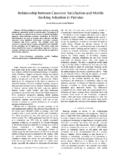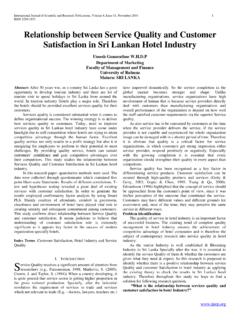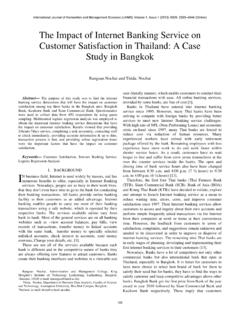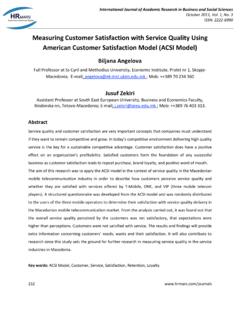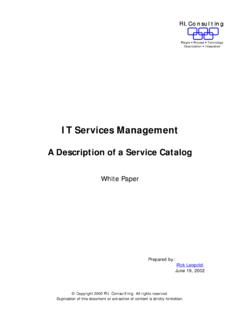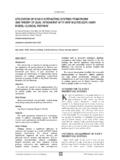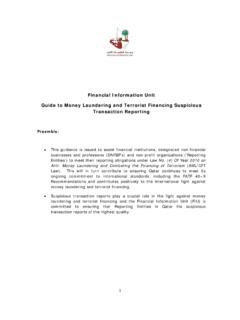Transcription of Consumer Online Shopping Attitudes and Behavior: …
1 Consumer Online Shopping Attitudes AND. BEHAVIOR: AN ASSESSMENT OF RESEARCH. Na Li and Ping Zhang Syracuse University Abstract The current status of studies of Online Shopping Attitudes and behavior is investigated through an analysis of 35 empirical articles found in nine primary Information Systems (IS) journals and three major IS conference proceedings. A taxonomy is developed based on our analysis. A conceptual model of Online Shopping is presented and discussed in light of existing empirical studies. Areas for further research are discussed. Keywords: Online Shopping , Consumer attitude, Consumer behavior, Web, empirical study Introduction Electronic commerce has become one of the essential characteristics in the Internet era.
2 According to UCLA Center for Communication Policy (2001), Online Shopping has become the third most popular Internet activity, immediately following e-mail using/instant messaging and web browsing. It is even more popular than seeking out entertainment information and news, two commonly thought of activities when considering what Internet users do when Online . Of Internet users, percent made Online purchases in 2001, with three-quarters of purchasers indicating that they make 1-10 purchases per year (2001, ). When segmented into very versus less experienced Internet users, the very experienced users average 20 Online purchases per year, as compared to four annual purchases for new users (2001, ).
3 Online Shopping behavior (also called Online buying behavior and Internet Shopping /buying behavior) refers to the process of purchasing products or services via the Internet. The process consists of five steps similar to those associated with traditional Shopping behavior (Liang and Lai 2000). In the typical Online Shopping process, when potential consumers recognize a need for some merchandise or service, they go to the Internet and search for need-related information. However, rather than searching actively, at times potential consumers are attracted by information about products or services associated with the felt need. They then evaluate alternatives and choose the one that best fits their criteria for meeting the felt need.
4 Finally, a transaction is conducted and post-sales services provided. Online Shopping attitude refers to consumers' psychological state in terms of making purchases on the Internet. There have been intensive studies of Online Shopping Attitudes and behavior in recent years. Most of them have attempted to identify factors influencing or contributing to Online Shopping Attitudes and behavior. The researchers seem to take different perspectives and focus on different factors in different ways. For example, Case, Burns, and Dick (2001, ) suggest that internet knowledge, income, and education level are especially powerful predictors of Internet purchases among university students according to an Online survey of 425 undergraduate and MBA students.
5 Ho and Wu (1999) discover that there are positive relationships between Online Shopping behavior and five categories of factors, which include e-stores' logistical support, product characteristics, websites' technological characteristics, information characteristics, and homepage presentation. Schubert and Selz (1999) examine the quality factors of electronic commerce sites in terms of information, agreement, and settlement phases. They also review those factors related to e-commerce community. These studies have all made important contributions to our understanding of the dynamics of Online Shopping field. However, there is a lack of coherent understanding of the impact of relevant factors on Online Attitudes and behavior and an inconsistent identification of relevant independent and dependent variables.
6 This makes comparisons of different studies difficult, applications of research findings limited, and the prospect of synthesizing and integrating the empirical literature in this area elusive. 508 2002 Eighth Americas Conference on Information Systems Li & Zhang/ Consumer Online Shopping Attitudes & Behavior The objective of this paper is to synthesize the representative existing literature on Consumer Online Shopping Attitudes and behavior based on an analytical literature review. In doing so, this study attempts to provide a comprehensive picture of the status of this subfield and point out limitations and areas for future research. Method As a phenomenon, Online Shopping became popular in the mid-1990s with the popularization of the World Wide Web (WWW).
7 Correspondingly, the subsequent years saw the appearance of research studies conducted to develop an understanding of users'. Online behavior. Given the fact that it usually takes a year or two to have a research published, we decided to restrict our search of research articles to the period of January 1998 to February 2002. The other two criteria for selection are (1) that the articles are empirical in nature, and (2) that the articles measure at least one of the identified factors in our taxonomy (see below). We systematically searched the following nine primary Information Systems (IS) journals: Communications of the ACM, Decision Support Systems, e-Service Journal, International Journal of Electronic Commerce, International Journal of Human-Computer Studies, Information Systems Research, Journal of the Association for Information Systems, Journal of Management Information Systems, and, Management Information Systems Quarterly.
8 In addition, we searched three primary IS conference proceedings volumes: International Conference on Information Systems (ICIS), Americas Conference on Information Systems (AMCIS), and Hawaii International Conference on Systems Science (HICSS). We also checked the reference sections of the selected articles to identify and include additional prominent articles in this area. A Taxonomy of Consumer Online Shopping Attitudes and Behavior A total of 35 empirical studies are analyzed in this study. Of these, 29 of them used survey method. Other research methods such as lab experiments and free simulation experiments are occasionally employed. Each of these studies addresses some aspect of Online Shopping Attitudes and behavior.
9 Our goal is to develop a taxonomy representing factors/aspects related to Online Shopping Attitudes and behavior covered in the existing empirical IS literature. For example, Bellman, Lohse and Johnson (1999) examine the relationship among demographics, personal characteristics, and Attitudes towards Online Shopping . These authors find that people who have a more wired lifestyle and who are more time- constrained tend to buy Online more frequently, , those who use the Internet as a routine tool and/or those who are more time starved prefer Shopping on the Internet. Bhatnagar, Misra and Rao (2000) measure how demographics, vender/service/ product characteristics, and website quality influence the consumers' attitude towards Online Shopping and consequently their Online buying behavior.
10 They report that the convenience the Internet affords and the risk perceived by the consumers are related to the two dependent variables ( Attitudes and behavior) positively and negatively, respectively. Jarvenpaa, Tractinsky, and Vitale (2000) investigate how consumers' perceived store size and reputation influence their trust in the store, risk perception, Attitudes , and willingness to buy at the specific store. They discover that there is a positive relationship between Consumer trust in Internet stores and the store's perceived reputation and size. Higher Consumer trust also reduces perceived risks associated with Internet Shopping and generates more favorable Attitudes towards Shopping at a particular store, which in turn increases willingness to purchase from that store.
